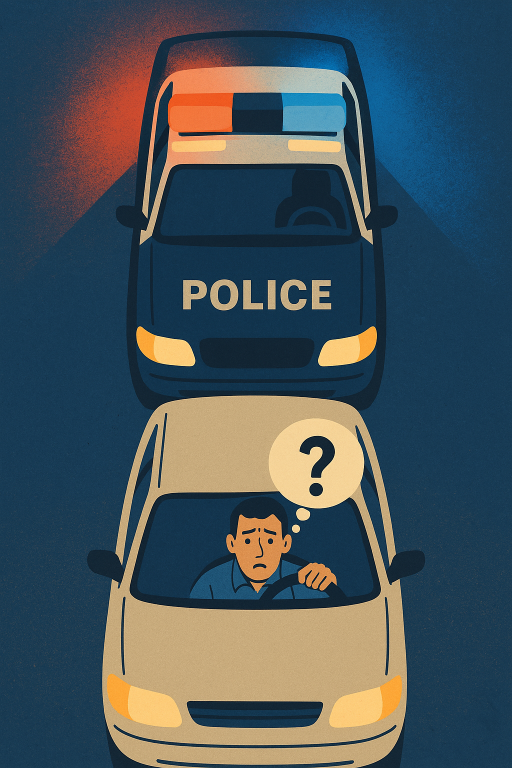When Police Lights Stay On: Law Enforcement Cruise Mode

I live in Hillsborough County, Florida. Within the last few months, our Hillsborough County Sheriff's Office (HCSO) and at least one other local agency have been using what they call cruise mode with their emergency lights. This is creating a lot of confusion for motorists, myself included.
In this mode, the emergency lights are steady and static while the deputy drives normally. The problem is you cannot tell if they want you to move over, pull over, or simply let them pass with priority. Traditionally, emergency lights flash, sometimes with sirens, which signals drivers how to respond. The issue is especially acute when a patrol car is directly behind you or approaching an intersection in front of you. I’ve been in both of these situations, and each time I was unsure how to react.
Apparently, HCSO received enough questions, complaints, and inquiries that local news media began covering the issue. At least one couple was involved in a serious accident linked to confusion over this policy.
- ABC Action News Tampa Bay (WFTS) report documents one such accident.
- FOX 13 Tampa Bay report explains the reasoning behind the new lighting mode.
One key issue is that HCSO did not widely publicize this change until after they had already begun using it. Nor did they hold any public hearings, request public input, or take comments about this non-statutory change. Florida law is clear about when emergency lights may be used and when emergency vehicles may claim special driving privileges:
- §316.2397(3)(c) Authorized emergency vehicles may operate emergency lights and sirens in an emergency. Online Sunshine
- §316.072(5)(a), a driver of an authorized emergency vehicle may claim special privileges when responding to an emergency call, transporting organs or surgical teams for transplant, pursuing a suspect, or responding to a fire alarm. The driver “may exercise the privileges set forth in this section, but subject to the conditions herein stated.” Online Sunshine
- The privileges in §316.072(5)(b) include parking or standing as needed, carefully proceeding past a red or stop after slowing, exceeding speed limits without endangering life or property, and disregarding movement or turning regulations without endangering life or property. Online Sunshine
- §316.072(5)(c) requires “due regard for the safety of all persons” and does not protect a driver from reckless disregard. Online Sunshine
- Separately, §316.126(3) says that when an emergency vehicle is en route to an existing emergency, it must warn other traffic by an audible signal or a visible signal using displayed blue or red lights, and otherwise proceed consistent with the traffic laws. Online Sunshine
The statute does not appear to authorize steady, non-flashing lights while the vehicle is driving normally. Cruise mode is also not mentioned in the Florida Driver’s Handbook, leaving motorists with no official guidance on how to respond:
Emergency Vehicles: Motorists, bicyclists, and pedestrians must yield the right-of-way to law enforcement vehicles, fire engines, and other emergency vehicles using sirens or flashing lights. Pull over to the closest edge of the roadway immediately and stop until the emergency vehicle has passed. Do not block intersections.1
This confusion is not theoretical. I experienced it first-hand a couple of months ago. A deputy was driving behind me with cruise lights on, and I had no idea if he wanted me to move over or not. He did not try to pass, so I continued driving normally through heavy traffic.
Another example happened just the other morning on the University of South Florida campus. A USF Police vehicle was coming the opposite way with static emergency lights on. It was 6:25 a.m. and still dark, so the lights were especially bright. I had a green turn arrow but hesitated because I did not know if he intended to proceed through the intersection. After three or four seconds, I realized he wasn’t moving, so I made my left turn. Even though I already knew about cruise mode, I was still uncertain.
If the law only permits these lights to be used in flashing emergency mode and requires officers to obey traffic laws otherwise, then this static always-on mode while on routine patrol does not appear to be supported by statute. It also creates unnecessary confusion, especially in a state with a large elderly population who do not need added uncertainty behind the wheel. In addition, tourists and residents from other parts of Florida where agencies do not use cruise mode face even more confusion. I understand the goal is to deter crime, discourage traffic violations, and increase visibility, but in practice cruise mode is causing more confusion and risk than it prevents.
Page 84 Official Florida Driver License Handbook as issued by the Florida Department of Highway Safety and Motor Vehicles 2025 Edition